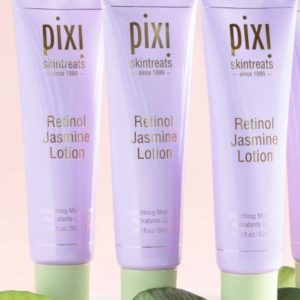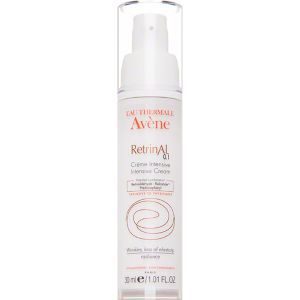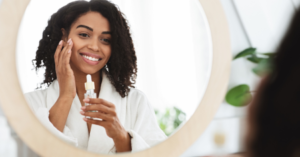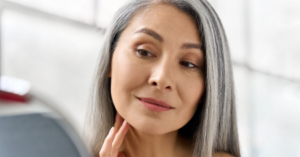Affiliate Disclosure: This Blog May Receive A Small Commission At No Extra Cost To You, For Purchases Made Via Affiliate Links. If You Decide To Support Our Blog In This Way, I Thank You!
In my opinion, women don’t usually need to start using retinoids until age 35-40. At that age, collagen starts to break down but you still have plenty of time to build it back up. However, if you have acne or you’re already showing a lot of sun damage, starting retin A or retinol or retinal might be a good idea. But which one is right for you?
If you’re planning to set foot into the mystifying world of retinoids, it’s important to familiarize yourself with the different types available on the market, particularly retinol and retinal. Read on to learn more about the ingredient, find out which retinoid may be best for you, and how to safely incorporate it into your routine.
How It Started
Retinoids are a class of compounds derived from vitamin A, and were first used as an anti-acne treatment in the 1970s under the brand name Retin-A. Shortly after being prescribed by doctors, users were noticing not just a clearer complexion, but they were also pleased to see fewer fine lines and a more even skin tone. But since Retin-A’s main active, retinoic acid (also known as tretinoin), is such a potent ingredient, users could only purchase the product with a doctor’s prescription.
The ingredient’s rise to skincare stardom did come with a few drawbacks though. Some patients reported that their skin became more sensitive to the sun, while others experienced dryness, flaking and irritation. While several of these accounts were likely caused by using Retin-A during the daytime (more on this later), or applying too much of the product in one session, researchers began exploring a milder form of the active ingredient: retinol.
To understand how retinol works versus other retinoids, you’ll need a bit of context on how our bodies absorb vitamin A. When not being used by the body, vitamin A is stored within our skin cells as retinol esters. Once ready to be metabolized, the esters are converted to retinol, followed by retinaldehyde (a.k.a. retinal), and then finally transformed into retinoic acid. To be clear, retinol is two steps away from retinoic acid, whereas retinal (retinaldehyde) is only step away from retinoic acid and therefore more powerful.
Prescription-strength retinoids like Retin-A are pure retinoic acid, which is why they work right away, but also come with an increased risk of side effects. Since retinol is less active compared to retinoic acid, researchers figured that it could be a good alternative for those with more sensitive skin, as our body will still have to convert retinol to retinal and then retinoic acid, making the ingredient weaker after each conversion, hence being less harsh on the skin overall. True enough, studies have found that retinol was able to yield the same fundamental results, albeit taking a little bit more time.
With consistent use, retinol was found to speed up cellular turnover and collagen production by neutralizing free radicals at the skin’s dermis. At the same time, it was also a lifesaver to those with sensitive and acne prone skin, as it kept breakouts at bay while keeping redness and flaking to a minimum.
How to use Retinol
While you can purchase retinol over-the-counter, you will still need to exercise caution when incorporating it into your routine—especially if you’re a first time user. For beginners, you can start by selecting a retinol product with a low concentration (ideally 0.1- 0.25%) and applying the product 1-2 nights a week for the first couple of months. It’s important to note that since vitamin A causes skin cells to shed faster than normal, you may experience the ‘retinoid reaction’ as your skin gets used to the ingredient. Since I began using Retin A for acne when I was 19, I got over that reaction early on but it wasn’t pretty. My skin was dried out and red for months!
To prevent this, you can opt for products with more emollients to reduce the potential side effects, or follow up with a rich moisturizer (especially if you have dry or sensitive skin) right after applying retinol. Another thing to remember is to only use retinol in your nighttime routine. Since retinoids are meant to increase cell turnover, the skin becomes temporarily thinner and more fragile, thus more prone to photosensitivity. In line with this, be sure not to skimp on the SPF the following morning as well to keep your skin protected from potential sun damage.
Once you’re sure that your skin can handle the formula, you can start using the product 2-3 times a week, and work your way up to using retinol every other day. When it comes to vitamin A, always remember that slow and steady wins the race. It can take anywhere between six weeks to three months to see initial results, so patience is definitely key.

Katharine Hepburn’s Brightening Secret
Before the age of chemical exfoliants, Katharine Hepburn relied on natural ingredients to achieve a fresh and radiant complexion. Combining lemon juice and sugar, she diligently scrubbed her face every night to remove dead skin cells and keep her skin smooth and clear.
What about RetinAl?
If you’ve already been using retinol for a while and still aren’t getting the results you want, retinal may be your best bet. Since retinal’s composition is more bioavailable, your skin will be able to absorb and reap its benefits a lot faster than its younger sister retinol. Being one conversion away from turning into retinoic acid, retinal is clinically proven to be 11x faster than retinol, and is the closest thing you can get to a prescription-strength retinoid.
That being said, you’ll want to make sure that your skin can really handle a stronger dose, since the extra boost does come with an increased risk of a ‘retinoid reaction’. Another advantage of retinal is that it’s the only retinoid with direct antibacterial properties, making it suitable for those with more severe acne.

Rita Moreno’s Anti-Acne Routine
Puerto Rican actress Rita Moreno used to scrub her face with a rough bristled brush daily to exfoliate her skin and lighten acne marks. Though the star admits that it was an aggressive technique, she said that it helped her achieve a clearer complexion in the long run.
Which Retinoid Is For Me?
The retinoid you choose ultimately boils down to your skin type and goals. For example, those with mature skin may prefer retinal for targeting wrinkles and fine lines, but younger users would probably go for retinol for a gentle brightening effect. As for those with acne or blemished skin, the type of vitamin A most suitable for you will depend on the intensity your skin can take. If your skin is on the sensitive side, retinol would be a good place to start. If you’re already sure your skin can handle the extra boost, start with the lowest concentration of retinal that you can find, and then slowly work your way up.
TOP 10 PRODUCTS TO GET THE JOB DONE:
For Retinol Beginners and Users With Sensitive Skin:
Paula’s Choice Intensive Repair Cream
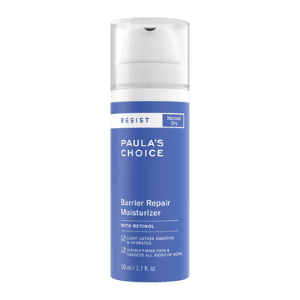
This repair cream from Paula’s Choice deeply hydrates the skin while renewing skin texture, and contains plenty of emollients like hyaluronic acid, peptides and jojoba seed oil to nourish the skin while targeting fine lines and wrinkles. The formula is perfect for those with sensitive or dry skin, or those who are just starting to use retinol. It’s also gentle enough to use on the eyes.
Pixi Skintreats Retinol Jasmine Lotion
Here’s another option for those looking for a lightweight moisturizer with a revitalizing effect. The formula is gentle enough for daily use, and is formulated with jasmine oil and peptides to keep the skin hydrated and plump. It is not technically a retinol but rather it contains a retinoid called retinyl palmitate which is a very mild retinoid, good for beginners.
For Experienced Retinol Users:
Dermalogica Overnight Retinol Repair is a concentrated cream with 0.5% microencapsulated retinol that speeds up cell turnover, and also contains vitamin C to help lighten dark spots. While the formula already has ceramides to hydrate and prevent water loss, the product also comes with a buffer cream that you can mix with the retinol treatment as your skin acclimates to the product.
Paula’s Choice 1% Retinol Treatment
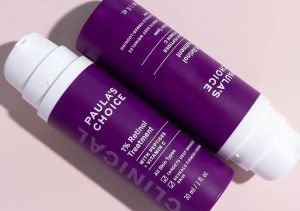
Paula’s Choice comes through again with a great product for skin that isn’t particularly sensitive, or if you’re looking for a product that’ll give you quicker results. With 1% retinol, antioxidants C and E, hyaluronic acid and skin-firming peptides, this serum was developed to reduce the size of pores, fade acne marks and combat signs of aging, leaving you with radiant and youthful skin.
Drunk Elephant A-Passioni Retinol Cream
This face cream from Drunk Elephant combines age-defying retinol with vitamin F, which helps improve skin texture while providing a calming effect to the skin. It’s also got a powerful blend of oils such as apricot, passionfruit and marula to keep the skin nourished, while kale and winter cherry give protection against environmental stressors.
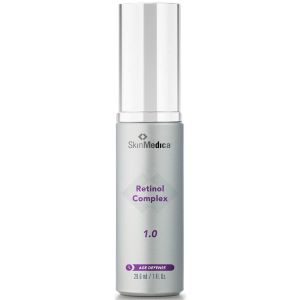
This serum by SkinMedica is their most potent retinol formula, but they also have a 0.25 variant for retinol newbies and a 0.5 variant for those looking for a medium strength formula. Aside from enhancing skin texture and reducing the appearance of wrinkles, the formula also contains antioxidants to protect the skin from free radicals, and bisabolol to calm the skin.
For Mature Skin And Advanced Vitamin A Users:
Medik8 Crystal Retinal Night Serum
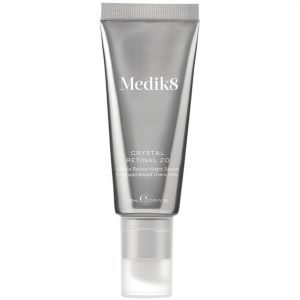
This retinal serum from Medik8 ranges in strength from .01 up to .1 in strength. The higher numbers like .06 or .10 are good choices for those with aged skin or skin that’s very used to retinoids. It will refine and firm the skin over time, but start out slowly. Not only does it provide anti-aging support, but it also helps control breakouts and lightens acne marks. You can purchase some of the strengths from Amazon, or go directly to their website for more information on these quality formulations. https://www.medik8.com/products/crystal-retinal
Avene RetrinAL 0.1 Intensive Cream
This Retinal cream from Avene was formulated for mature and dry skin, and reduces the appearance of wrinkles and deep lines while smoothing the skin. Combined with antioxidants and peptides, it also helps keep skin plump, firm, and protected from free radicals. But for those looking for a more gentle formula, Avene also has a 0.05 variant of their RetrinAL cream.
MyChelle Dermaceuticals Remarkable Retinal Serum
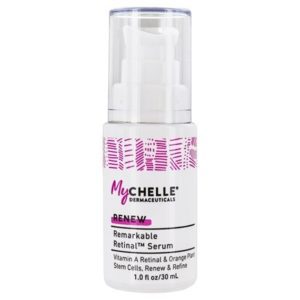
MyChelle’s retinal serum has a patented-process retinal and is formulated with orange plant stem cells to help diminish fine lines and even out one’s skin tone. Plus, it also contains ceramides to help lock in moisture and protect the skin from environmental stressors.
Obagi Retivance Skin Rejuvenating Complex
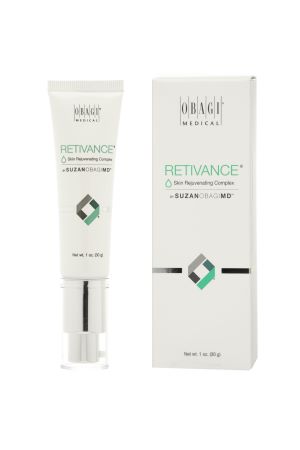
This 3-in-1 serum includes retinal, peptides, and antioxidants to improve the skin’s elasticity, reduce wrinkles and brighten dull skin, and comes in a rich base with chamomilla recutita flower extract to reduce irritation and soothe the skin.
Conclusion:
As long as you know these basics about retinoids, you’ve got nothing to lose and everything to gain from using this ingredient. Back off if skin becomes irritated and be sure to wear at least SPF 30 every single day!
Share your retinol experience in the Comments section below!
To read more about effective skincare ingredients, see our post WHAT’S SO SPECIAL ABOUT AHAS…?

